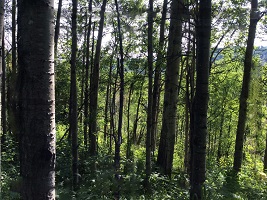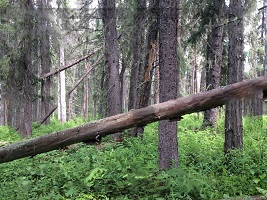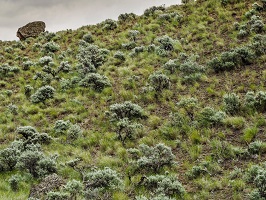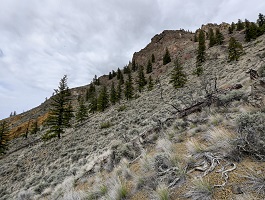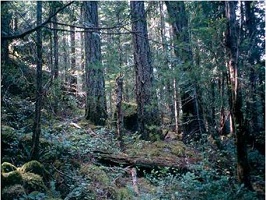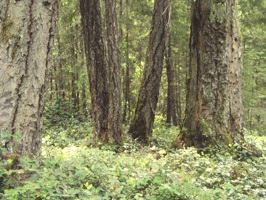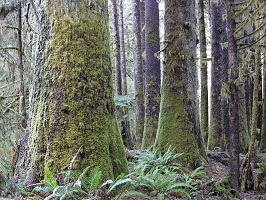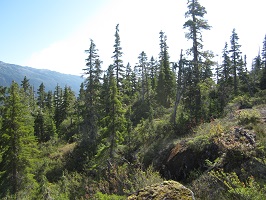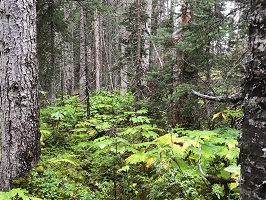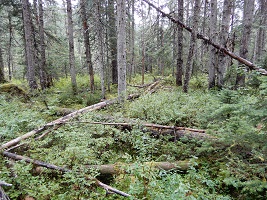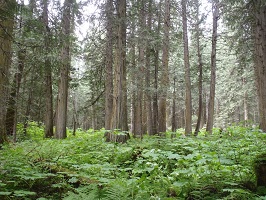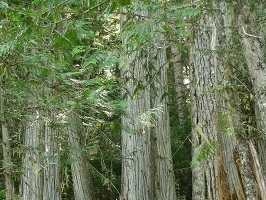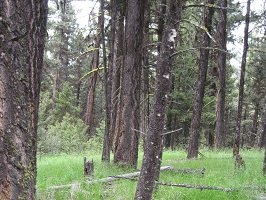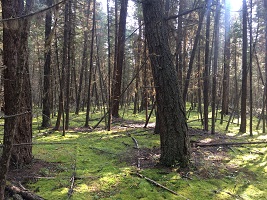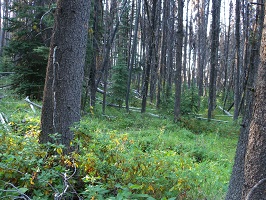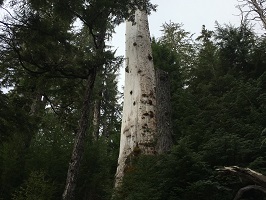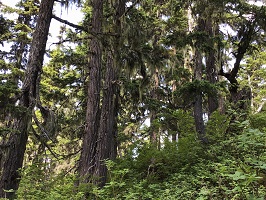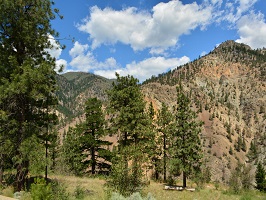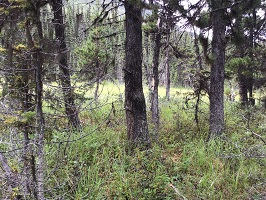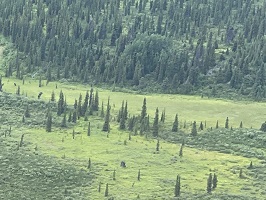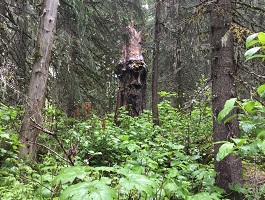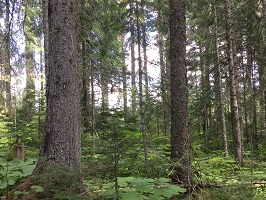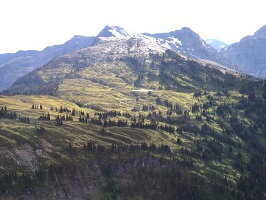Old growth forest images
Old growth forests provide important and unique wildlife habitat for species across the province. The length of time between forest stand replacing disturbances (eg: fire, insect kill, harvest activities) contributes to unique habitat values because ecological processes over long time periods allow for the development of structural habitat niches and species communities not found in younger stands. Old growth forests look different across ecosystems.
Boreal White and Black Spruce (BWBS)
This zone is part of the extensive belt of boreal coniferous forest occurring across Canada. It occupies the northern valleys west of the Rocky Mountains and the gently rolling topography of the Great Plains. Winters are long and cold and the growing season short; the ground remains frozen for much of the year. Numerous past fires have created extensive successional forests of aspen and lodgepole pine. Where flat, the landscape is typically a mosaic of black spruce bogs and white spruce and trembling aspen stands.
Bunchgrass (BG)
This grassland zone is confined to the lower elevations of the driest and hottest valleys of the southern interior. Bluebunch wheatgrass is the dominant bunchgrass on undisturbed sites. At the lower elevations big sagebrush is common particularly on overgrazed areas. Ponderosa pine and Douglas-fir occasionally occur in draws and on coarser textured soils although the harsh climate restricts their growth.
Coastal Douglas-fir (CDF)
In the lee of the Olympic and Vancouver Island mountains a mild "mediterranean" type of climate prevails. These rain shadow coastal forests are dominated by Douglas-fir, with an understory commonly consisting of salal and/or Oregon grape. Western redcedar is typical of wetter sites and Garry oak and arbutus are abundant on drier sites.
Coastal Western Hemlock (CWH)
The rainforests comprising this zone occur from sea-level to montane elevations along the coast depending on latitude. Western hemlock and amabilis fir are the dominant climax trees, although several other species are also common. Abundant rainfall and mild temperatures make these forests the most productive in Canada. In the old growth forests, Douglas-fir can approach 100 metres in height; on river bottom soils, western redcedar and Sitka spruce can reach up to four metres in diameter.
Engelmann Spruce Subalpine Fir (ESSF)
This is a subalpine zone occurring at high elevations throughout much of the interior. The climate is severe, producing short cool growing seasons and long cold winters. Only those trees capable of tolerating extended periods of frozen ground occur. Engelmann spruce, subalpine fir, and lodgepole pine are the dominant trees. The landscape at the upper elevations is open parkland, with trees clumped and interspersed with meadow, heath, and grassland.
Interior Cedar Hemlock (ICH)
This zone occurs at lower to middle elevations in the interior wet belt of the Province. Winters are cool and wet, and summers are generally warm and dry. This zone has the widest variety of coniferous tree species of any zone in the Province. Western hemlock and western redcedar are characteristic species but spruce (white-Engelmann hybrids), and subalpine fir are not unusual. Douglas-fir and lodgepole pine are generally found on drier sites.
Interior Douglas-fir (IDF)
This is the second warmest forest zone of the dry southern interior, occurring in the rain shadow of the Coast, Selkirk and Purcell mountains. Douglas-fir is the dominant tree. Fires have frequently resulted in even-aged lodgepole pine stands at higher elevations while ponderosa pine is the common seral tree of the lower elevations. Along its drier limits the zone often becomes savannah-like, supporting bunchgrasses including rough fescue and bluebunch wheatgrass.
Montane Spruce (MS)
The MS zone occurs in the south-central interior at middle elevations and is most extensive on plateau areas. The winters are cold and summers moderately short and warm. Engelmann and hybrid spruce, and varying amounts of subalpine fir are the characteristic tree species, however, due to past wildfires successional forests of lodgepole pine, Douglas-fir and trembling aspen are common.
Mountain Hemlock (MH)
As a subalpine zone occurring at high elevations along the Pacific coast, the growing season is short and the annual snowfall is high. Throughout most of the zone, the forest is continuous with mountain hemlock and amabilis fir as the dominant trees, as well as varying amounts of yellow-cedar. In the upper elevations, forests thin out into open parkland, where trees are clumped and interspersed with sedge or mountain-heather communities.
Ponderosa Pine (PP)
The PP is the warmest and driest forest zone. It is confined to a narrow band in the driest and warmest valleys of the southern interior where it often borders the Bunchgrass Zone along its lower or drier limits. Ponderosa pine is the dominant tree and frequent ground fires are important for creating and maintaining widely-spaced pine stands with a bunchgrass understory. Douglas-fir is common on the colder and moister sites.
Spruce Willow Birch (SWB)
This is a subalpine zone occurring in the severe climate of the north of the Province, at elevations above the boreal forest and below the alpine tundra. At lower elevations, the zone is characterized by open forests of primarily white spruce and subalpine fir; upper elevations are dominated by deciduous shrubs including scrub birch and willow. In some high wide valleys, cold air collects resulting in a mosaic of scrub, grasslands and wetlands.
Photos coming soon
Sub-Boreal Pine Spruce (SBPS)
The SBPS zone occurs on the high plateau of the west central interior in the rain shadow of the Coast Mountains in an area with a cold, dry climate. As a result of an extensive fire history, the zone is characterized by many even-aged lodgepole pine stands. The plateau landscape is dotted with numerous non-forested wetlands.
Sub-Boreal Spruce (SBS)
Occurring in the central interior of the Province primarily on gently rolling plateaus, this zone has a fairly severe climate, however, the winters are shorter and the growing season longer than in boreal areas. Hybrid Engelmann-white spruce and subalpine fir are the dominant trees; extensive stands of lodgepole pine occur in the dryer portions of the zone due to numerous past fires. Wetlands are abundant, dotting the landscape in poorly drained areas.
Alpine Tundra zones:
- Boreal Altai Fescue Alpine (BAFA)
- Coastal Mountain-heather Alpine (CMA)
- Interior Mountain-heather Alpine (IMA)
There are three alpine zones recognized on high mountains throughout the Province, differentiated by climate and vegetation. Long, cold winters and a short, cool growing season create conditions too severe for most woody plants except in dwarf form, which means that any tree species growing here may reach an old age but appear small in stature. The alpine zones include areas of parkland consisting of small patches of trees interspersed with alpine meadows. The vegetation in alpine zones is dominated by dwarf shrubs and heaths, herbs, mosses and lichens.

